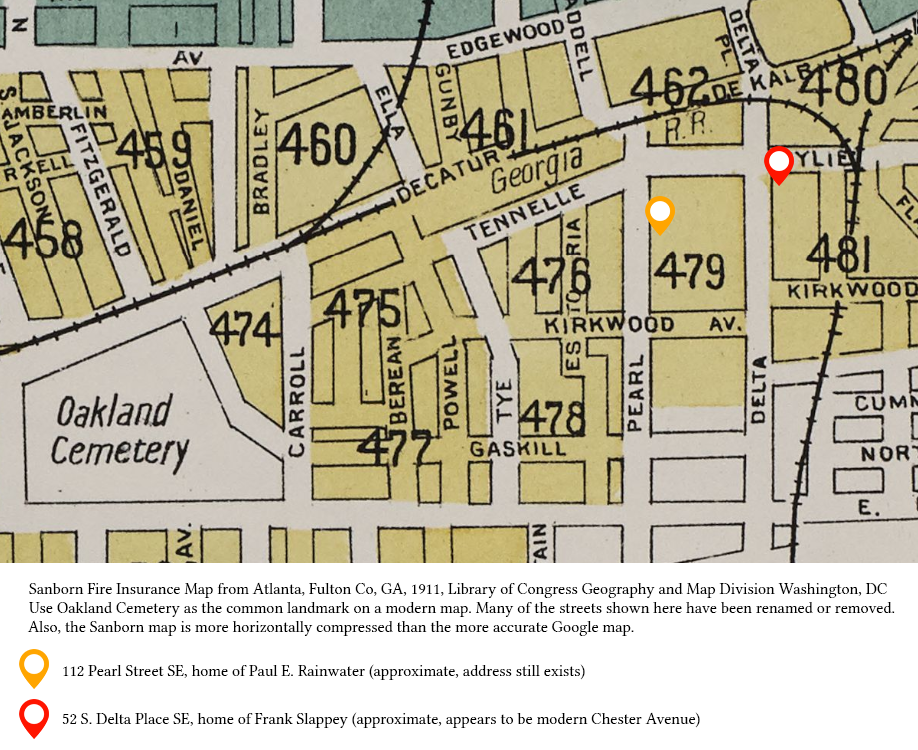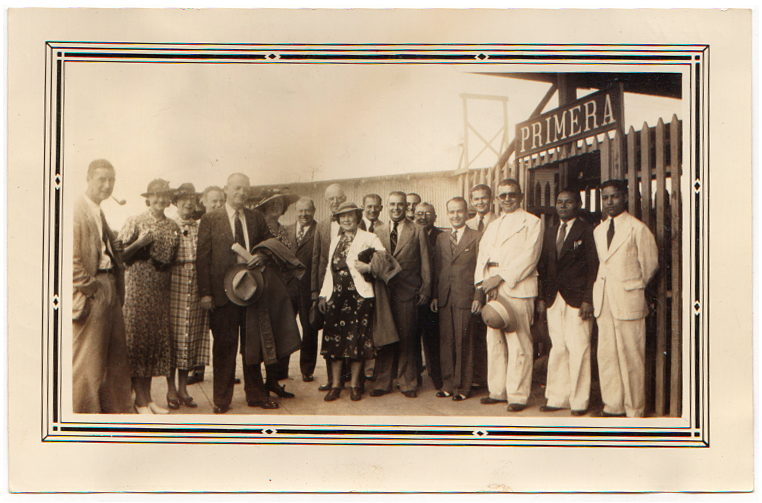Paul E. Rainwater: A black sheep gets a second chance at life in Dallas

DGS 2022 Writing Contest Submission: Your family’s black sheep
Paul Edward Rainwater (1885-1945), son of Charles Allison Rainwater and Cornelia Jane Veazey
by Susan Chance-Rainwater
On 26 Feb 1900, the Atlanta Constitution newspaper reported the story of a fight between two teenaged boys1 that ended in the murder of one by the other. [m]
According to the article, 14‑year‑old Paul Rainwater and his friend, Barry Langford, were playing in their neighborhood in southeast Atlanta. They passed the home where the Slappey family lived, and Rainwater stopped to pat the Slappey’s dog. Paul’s affection towards their dog had long irritated Willie and Frank Slappey, who treated it carelessly. The two boys began to taunt Rainwater, insulting Rainwater’s late mother, provoking the fight. [m] [o]
The taunt was reported as both “you are no better than the dog” and “the dog is better than your mother.” Neither seems worth starting a fatal fight over, unless Paul’s understanding of the remark was – you love that dog more than you loved your deceased mother.
In the course of the fight, Paul Rainwater pulled out a pocket knife, and stabbed Frank Slappey at least twice, once in the abdomen and once between the seventh and eighth ribs. Mrs. Slappey broke up the fight and then called for a doctor. Frank died at Grady Hospital later that day. [m] [o] [w]
The article identifies Paul Rainwater as the son of C. A. Rainwater, a wagon maker, who lived at 112 Pearl Street SE. This address still exists on modern maps. [m]
Frank Slappey was identified as the son of John Slappey, a butcher working for a dry goods company. [m] The Slappey family lived at 52 S. Delta Place SE, the location of the murder. [y] This address doesn’t exist on modern maps. Many of the streets in this neighborhood have been renamed in the course of recent redevelopment.
Comparing a 1911 Sanborn Fire Insurance Map to Google Maps, I was able to approximately identify the two addresses. Anchoring my view to Oakland Cemetery, a feature the two maps had in common, and several streets that still have the same names, I was able to determine that Delta Place is now called Chester Avenue once it crosses south of Decatur Avenue. Many of the older houses still standing on Chester are duplexes. 52 Delta Place would have been the north half of a duplex at the corner of present‑day Chester Avenue and Wylie Street. [s]

Thus the Rainwater and Slappey homes were within a block of each other.
I worked out the addresses because I came at this problem from the end of Paul Rainwater’s life, when he was a respected Dallas electrical contractor. Upon first encountering the articles describing the murder case, I was certain it was a different Paul Rainwater. The map convinced me otherwise.
Paul Rainwater and Barry Langford were arrested on February 25th. Langford was charged with assault and battery. Rainwater was charged with voluntary manslaughter. [k]
On March 1st, Paul Rainwater appeared in the courtroom of Justice Simeon H. Landrum. The judge surprised all present by disqualifying himself from the case, on the grounds that he was related to Paul Rainwater.2 [n]
On March 3rd, the case was assigned to Justice J. M. Bateman, who fixed Rainwater’s bond at $500 and heard the initial evidence. Two African-American girls, Queenie Thomas and Cornelia Hood, testified that they witnessed the fight, and Thomas said she saw Rainwater stab Slappey. [k] [n] [o]
By March 7th, the case had gone before the coroner’s jury, which issued a “true bill for murder.” Rainwater’s bond had been increased to $3,000 owing to the severity of the crime. The bond signed, Rainwater was released and returned to school, where the newspaper reported he was “heartily welcomed by his classmates and teachers” as if the event had been a schoolboy scuffle. [p]
In fact, the teachers at Edgewood Avenue School were quick to speak up for Rainwater, days before the case went to the coroner’s jury, calling him “a perfect gentleman, thoughtful of others, studious, attentive to his work.” [v] These unsolicited accolades make me think the teachers didn’t wish to speak ill of the dead, but were hinting that everybody knew Frank Slappey was a bully.
The case went to trial in the fall and received little press coverage until the verdict was announced. The foreman of the jury was local legend Joel Chandler Harris, author of the Uncle Remus stories. [ee] Paul Rainwater was convicted of involuntary manslaughter in late October and was sentenced to one year in prison.
At this point, the Rainwater family’s connections organized an effort to overturn the conviction. How exactly these individuals were connected to the Rainwaters – by family, or through church or business – it isn’t entirely clear.3
Judge John Slaughter Candler requested that the prison commission send Rainwater to Milledgeville Reformatory, to keep the boy away from hardened criminals. [q] [z] Rainwater’s lawyers, the Westmoreland Brothers Law Firm, claimed the evidence in the case was insufficient, and that the boy had acted in obvious self-defense. Additionally, several of the jurors objected, saying they hadn’t expected such a harsh sentence. [l]
In the meantime, Rainwater was held in the Fulton county jail on Butler Street, known as “The Tower” for the architecturally disproportionate tower on the right front corner of the building. [u] [bb]
Eventually these requests for a pardon reached the desk of Governor Allen Daniel Candler, who commuted the sentence to 60 days, to begin on the date of his conviction (in other words, counting the time already served). Candler’s cited Rainwater’s good character, Christian home life, and the testimony of his teachers on his behalf, as well as a desire to mitigate the suffering of his family. [q] [t]
Life After Commutation

On Christmas Eve 1900, Paul E. Rainwater was released from “The Tower.” [u] Within a year, his family sent him to Dallas, Texas, to give him a new start in life.
Why Dallas? While there were other Rainwaters living in Dallas, none were closely related to Paul Rainwater. It appears to me that Dallas was the largest city in a straight line from Atlanta on the railroad. It was a place to start anew, and large enough that no one would recognize Rainwater’s name or his past offense.
He is listed in the 1903 Dallas city directory as an office boy. In 1905, he’s listed as a teamster. In 1907, he’s listed as an engineer. By 1910, he lists his occupation as an electrician for the light company. Based on the 1903 and 1910 entries, all of these jobs were for the same company – Dallas Electric Power & Light. He lived in a succession of rooming houses. [y] [dd]
In about 1915, Paul Rainwater married Minnie Pearl Qualls. They lived for a while on Rosita Farm in Eagle Pass, Maverick County, Texas, with Minnie’s father, but returned to Dallas in 1928 when Mr. Qualls’ health failed. [j]
Rainwater set himself up as a consulting electrical engineer. In the 1930s, he became an advisor to Compañía de Alumbrado Eléctrico de San Salvador, where he served until 1938, based on a commemorative album sold on Ebay in March 2002. One of the photos shows Rainwater standing with General Maximiliano Hernández Martínez, who became dictator-president in 1932. [g] [h] [i] [aa]
The couple retired to Grapevine, Texas, where Paul Rainwater died in 1945. His obituary says he is to be buried in Grapevine Cemetery, but this is incorrect. He was buried in Five Mile Cemetery in Oak Cliff, Dallas, Texas, with his wife and Qualls in-laws. Paul’s sister Miriam Josphine Rainwater, who spent most of her adult life living in far north Texas, is also buried with this family. [a] [b] [c] [d] [e] [f] [x]
Paul Rainwater and his wife had one son, Paul Edward Rainwater, Jr., who is buried with his parents in Five Mile Cemetery. [d] [x]
Notes
1 Children, boys, playmates, youngsters. These articles insist on referring to Paul Rainwater and his victim, Frank Slappey, as if they were children. From a contemporary vantage point, we would refer to them as teenagers.
2 Landrum-Rainwater connection. Justice Simeon H. Landrum was the grandson on his mother’s side of Daniel Underwood, whose son George Carter Underwood married Mary Ann Veazey, whose parents were Jesse Veazey and Sallie Akins. Mary Ann Veazey’s brother, Eli Akins Veazey, was Paul Rainwater’s great-grandfather. Daniel Underwood’s daughter, Sarah Mahala Underwood, was Simeon Landrum’s mother. Charting this out, it appears to me that Simeon Landrum and Paul Rainwater were 1st cousins once removed. The Veazey, Underwood, and Landrum relationships have been documented on the Thomas/Shiers/Jackson/Adair Family Tree created by Naomi Vickers on Ancestry.com, and independently confirmed by me. [cc] [dd]
3 Candler-Rainwater connection. If you live in Atlanta, you know that the name Candler is synonymous with Coca-Cola. Paul Rainwater’s brother, Charles Veazey Rainwater, went to work for the Coca‑Cola Company in 1902, rising to the position of Secretary‑Treasurer by 1906. How the Rainwaters were connected to the Candlers prior to 1902 is unknown to me, but clearly they intervened in gaining Paul Rainwater’s commutation. All of these families – the Akins, Candlers, Underwoods, Veazeys, Landrums, and Paul’s branch of the Rainwaters – were originally from Greene Co, Georgia.
Acknowledgements
Thanks to Jim Thornhill of the Dallas Genealogical Society, and Crystal Brooks, genealogical librarian at the Dallas Public Library, who helped pull some of the newspaper articles I needed. I could not have completed this project without their assistance.
Sources
- [a]: Texas Death Record Index, 1941-1945, K-Z, Roll #9, Texas State Department of Health Records and Statistics, microfilm
- [b]: Cemeteries of Northeast Tarrant County, Texas, Evelyn D’Arcy Cushman, 1981, Fort Worth, TX
- [c]: Genealogical Data from Early Dallas County, Texas Cemeteries, Vol. 5, Five Mile Cemetery, Dallas Genealogical Society, microfische, 1981, Dallas, TX
- [d]: Rainwater tombstones in Five Mile Cemetery, West Kiest Blvd., Dallas, Dallas County, Texas, photographed by R. Steven Rainwater and Susan Chance-Rainwater, 3 Sept 2001
- [e]: Obituary of Paul Edward Rainwater, 5 Sep 1945, Dallas Morning News, Dallas, TX, pg 9
- [f]: Obituary of Paul Edward Rainwater, 5 Sep 1945, Fort Worth Star Telegram, Fort Worth, TX, pg 19
- [g]: Title page of album presented to Paul E. Rainwater, Sr., Nov 1938, by the Compañía de Alumbrado Eléctrico de San Salvador, offered for sale on Ebay, March 2002, scan of original
- [h]: Photograph; Paul E. Rainwater, Sr. and wife with officials of the Compañía de Alumbrado Eléctrico de San Salvador in front of the Primera gate, ca 1938, purchased on Ebay, March 2002, original owned by R. Steven Rainwater
- [i]: Photograph; Paul E. Rainwater, Sr. with President-General Maximiliano Hernandez Martinez (1931-1944) of San Salvador, inspecting an electrical substation of the Compañía de Alumbrado Eléctrico de San Salvador, offered for sale on Ebay, March 2002, scan of original
- [j]: Photograph; Paul E. Rainwater, Jr. with mother, Pearl Qualls Rainwater, ca 1918‑1919, Rosita Ranch, Eagle Pass, Texas, offered for sale on Ebay, March 2002, original now owned by R. Steven Rainwater
- [k]: “Boy Slayer Bound Over,” pgs 1 & 3, The Sandersville Herald, Sandersville, GA, 8 Mar 1900
- [l]: “Wants Pardon For Rainwater,” pg 5, The Morning News, Savannah, GA, 30 Oct 1900
- [m]: “Frank Slappey stabbed to death; Paul Rainwater is under arrest,” pg 7, column 1, The Atlanta Constitution, Atlanta, GA, 26 Feb 1900
- [n]: “Rainwater’s trial today: Paul Rainwater, slayer of Frank Slappey, to be given a commitment trial this morning,” pg 5a, column 4, The Atlanta Constitution, Atlanta, GA, 1 Mar 1900
- [o]: “Paul Rainwater was bound over: he now stands charged with voluntary manslaughter,” pg 12, column 1, The Atlanta Constitution, Atlanta, GA, 3 Mar 1900
- [p]: “Increase made in Rainwater’s bond. Grand jury had returned a true bill for murder against him,” pg 4, column 5, The Atlanta Constitution, Atlanta, GA, 7 Mar 1900
- [q]: “Sentence was commuted; boy who killed his playmate gets sixty days in jail,” The Morning News, pg 2, 17 Nov 1900, Savannah, GA
- [r]: “Boy sentenced,” pg 1, The Brunswick Times-Call, Vol XI, No 62, 8 Oct 1900, Brunswick, GA
- [s]: Sanborn Fire Insurance Map of Atlanta, Fulton Co, GA in 1911, plates 458-481. Library of Congress Geography and Map Division, Washington, DC
- [t]: “Paul Rainwater shown clemency: youthful slayer of Frank Slappy escapes penitentiary. The commutation given yesterday by Governor Candler practically amounts to pardon.” pg 10, 17 Nov 1900, The Atlanta Constitution, Atlanta, GA.
- [u]: “Paul Rainwater released: has served sentence for killing his young playmate, Frank Slappey–home last night,” pg 10, 25 Dec 1900, The Atlanta Constitution, Atlanta, GA.
- [v]: “They speak for Rainwater–his teachers testify to the boy’s good character at school,” pg 5, 28 Feb 1900, The Atlanta Constitution, Atlanta, GA
- [w]: Findagrave #45760069, Frank Mitchell Slappey, East View Cemetery, DeKalb Co, GA
- [x]: Findagrave #34618716, Paul Edward Rainwater, Five Mile Cemetery, Dallas, TX
- [y]: Ancestry.com, U. S. City Directories, 1822-1995, online database
- [z]: Baldwin County (Georgia) Cemeteries, Georgia State Penitentiary at Milledgeville, website maintained by Susan J. Harrington, http://www.friendsofcems.org
- [aa]: Wikipedia, El Salvador, https://en.wikipedia.org/wiki/El_Salvador#20th_century
- [bb]: Geoff’s Atlanta Block Party blog, Fulton County Jail, posted 21 Oct 2014, http://atlantablockparty.blogspot.com/2014/10/
- [cc]: Thomas/Shiers/Jackson/Adair Family Tree, Naomi Vickers, Ancestry.com
- [dd]: 1900-1940 Federal Censuses
- [ee]: “Boy’s murder trial; Uncle Remus, juror,” The Atlanta Journal, Atlanta GA, 27 Oct 1900, pg 3
©2022 Susan Chance-Rainwater
Published by Dallas Genealogical Society with the author’s permission

